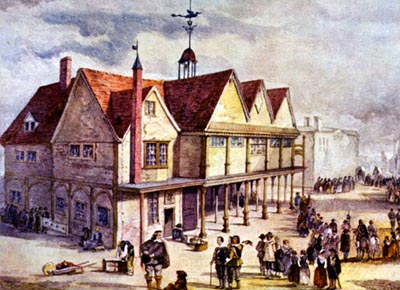 |
 |
|||
|
|
This was the New Borough of Berkshire, probably founded by Arnulf De Hesdin in the 1070s. One of many new towns set up around the country just after the Norman Conquest, it had previously been the site of the village of Ulverton. They were just like those of the 1960s, designed to centralize commerce and industry in the local area, and thus bring increased revenues to the Lord of the Manor. It was originally part of the parish of Thatcham, which helps explain the great rivalry the evolved between the two towns. Reports of Newbury Castle have been vastly overstated. It is unfortunate for the town, which has always displayed the building with pride on its coat of arms. It has recently been proved that there is only one definite record of the castle's existence: that in an old French journal, telling how it was besieged by King Stephen in 1153. This would indicate a very lightweight motte and bailey affair that probably disappeared shortly after its capture. Archaeological investigation has shown no sign of it around the traditional site, down at the Wharf. The castle may have stood anywhere in the local area, possibly in Hamstead Marshall. King John knew Newbury well, visiting with his son in 1200. He is said to have founded St. Bartholomew's Hospital in the town around the same time. He is also said to have later been hidden in the town by an old spinning woman, when escaping the the Rebel Barons who had risen up against him. Newbury was the property of the rebel Duke of York during the War of the Roses (15th c.). The town was taken by the Earl of Wiltshire in 1460, and he executed many of the townsfolk for supporting York. They were hanged, drawn and quartered. The Duke's son later became Edward IV, and Newbury became a Royal Borough. It was also one of the meeting places for the followers of the Duke of Buckingham's Rising against Richard III in 1483. Jack O'Newbury was a poor runaway who became an apprentice clothier in this town. He eventually married his boss's widow and became so rich that he was able to build the first true factory in Britain. The facade of his house, still called 'Jack O'Newbury's House' can be seen in Marsh Lane, down the side of Marks and Spencer's, and many stories are told of the happenings there. Jack and his son totally rebuilt St. Nicholas' Church and his insigniae can be seen throughout the roof bosses. It is similar to the elaborate churches of Suffolk also built by local cloth-merchants. The church has the most fantastic font cover and Jack's brass can be seen under the tower. That of his son has disappeared. It was here that the trial of the Newbury Martyrs took place. Three protestants were convicted of heresy during Bloody Mary's reign and burnt at the stake off the Enborne Road. The town museum is housed in the Old Cloth Hall. It is a beautiful Jacobean three-storeyed building with a first floor overhang and carved woodwork. It houses some fascinating exhibits including a replica of the Newbury Coat made in an hour quicker than the original. Stretching back along Wharf Street from here are the Old Granaries. They are an interesting group of Charles II buildings with a galleried upper storey: one of the few of this type remaining in the country.
It was from Newbury that the authorities marched on the Agricultural Machine Rioters of West Berkshire in November 1830. High Sheriff John Walter called for all those who could muster a horse to gather in the town's market place and join the Grenadier Guards sent from London. More troops assembled at outlying areas and together they marched on Kintbury, where the rioters had gone to earth. The town hall later became the offenders' gaol. Newbury was the Kennetbridge of Thomas Hardy's Jude the Obscure. Jude visited the town to call on the composer of a hymn that haunted his mind. Click for the Newbury
Stop on the Berkshire Towns Tour |
|||
| © Nash Ford Publishing 2001. All Rights Reserved. | ||||




 Newbury
Newbury Newbury
supported the Parliament during the Civil War, but, at the
Newbury
supported the Parliament during the Civil War, but, at the